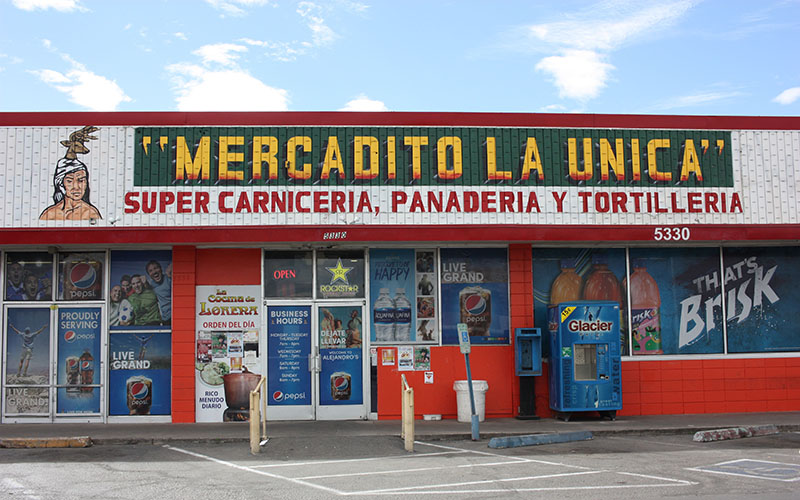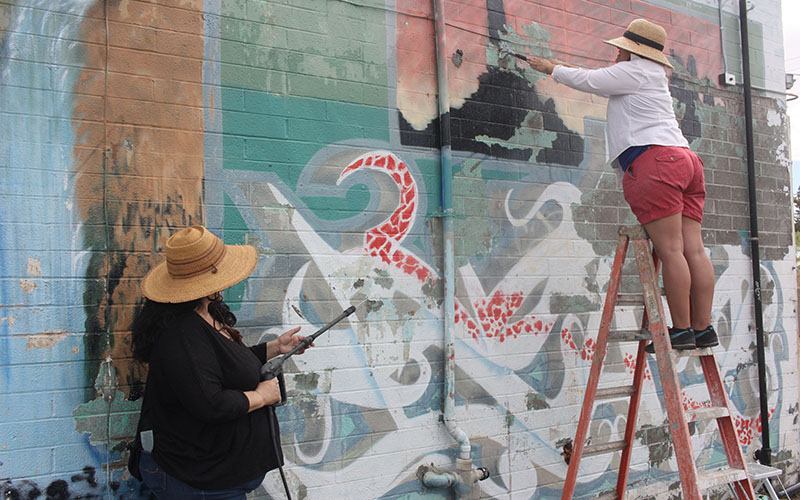TUCSON – Wielding paint scrapers and a power washer, Alex Jimenez and Johanna Martinez approached the exterior wall of an ice cream shop in the heat of a late March afternoon, preparing the canvas where they’ll document some of the history of Tucson’s south side.
Jimenez, who was raised and currently lives in the predominantly Hispanic part of the city (not to be mistaken with South Tucson), has been studying the typography of signage in the area for years. Hand-painted signs for streets, restaurants, grocery stores, and other businesses inspired her to delve deeper into the stories of the people behind them.
“You had to be seen as remarkable to get history told about you (in Tucson),” she said. “I don’t really like that approach.”
What started as her University of Arizona thesis project on typography in 2014 has grown into a grant-funded deal to paint a mural and publish a book documenting the history of the immigrant communities and families in the south side.
Jimenez and her sister Sharayah, an architect who works in historic preservation, have been interviewing residents and business owners in the area from downtown Tucson to Sixth and 12th avenues. Many of the families, including their own, have lived on the south side for several generations.
“We live in a community that is underserviced (sic), underrepresented, and just a kind of area of town that a lot of people write off as the bad side of town,” Sharayah Jimenez said. “But really that’s not what we grew up experiencing.”
The project, funded by a grant from the Arts Foundation for Tucson and Southern Arizona, includes a mural on the wall of Oasis Fruit Cones on 12th Avenue and Columbia Street, as well as a book about the typography and history of the area titled “Abecedario del Sur” (alphabet of the south).

Alex Jimenez holds a prototype of her book “Abecedario del Sur,” which documents some of the history of Tucson’s south side through its typography and signage. (Photo by Sarah Jarvis/Cronkite News)
Alex Jimenez has already published a more simplified children’s version of the book titled “Abecedario del Sur Seek & Find Alphabet Book.”
“Abecedario del Sur” will include the oral history of the residents of the south side through the signage, while the mural, titled “The Talking Mural,” will showcase some of the more visual elements of the collective history. Alex Jimenez is working with muralist Johanna Martinez to have the mural completed by June.
Martinez said she and Alex Jimenez are still in the process of interviewing people, including the owners of Oasis, to help them decide how to design the mural. The old mural on the side of Oasis was faded, the dark brick beneath it exposed in some places. Martinez said it was painted in 1992 by some friends of hers.
“Even though it looks like we’re just scraping paint, we’ve actually been reviewing a lot of audio and sketching and trying to lay it out,” Martinez said. “Some stories might be great and interesting, but visually, translating them might not be great.”
In addition to the history of the south side, Sharaya Jimenez said it’s important to capture the area as it is now. The area around the south side, particularly the city of South Tucson, is in the midst of a lot of development, she said.

Alex Jimenez holds a prototype of her book “Abecedario del Sur,” open to a page showing a map where each letter she highlights in the book is found in Tucson’s south side. (Photo by Sarah Jarvis/Cronkite News)
And even though the south side is “one of the last strongholds of mom-and-pop style businesses,” as Sharayah Jimenez said, there have been some changes in the area since the project began. One of the letters included in the book from a sign painted to look like ropes on the side of a restaurant is no longer there.
“The book captures a moment in time,” Sharayah Jimenez said. “(We are) trying to document the feel of things.”
She said it’s ironic that urban developers around Tucson are trying to create cities with walkable streets and local businesses: that already exists on the south side. Other questions regarding the authenticity and appropriation of Mexican-American style and culture have abounded as she has studied and interviewed residents for the book, she said.
“I often feel like people take these things but the culture itself is gone,” she said. “I wonder about that all the time, about our culture being taken and sold to us, but the culture itself not being valued.”
Debi Chess Mabie, executive director of the Arts Foundation for Tucson and Southern Arizona, said the foundation chose to award Alex Jimenez a $2,500 New Works grant because of her unique approach combining arts and aesthetics with the history of the area.
“We hadn’t seen that type of interpretation or reflection of that community in that way,” she said. “If you’re not as familiar with the history of the south side of Tucson, this is a great introduction.”
She said Alex Jimenez has a deep reverence and respect for her community that translates to viewers regardless of their knowledge of the south side.
“Alex’s project has forced them to look really deeply,” really closely, like stop slow down really pay attention,” she said. “If you really pay attention to that sign, in the letters in the paint, you will see a history of that community.”
Alex Jimenez said she was inspired by the stories of those she interviewed, particularly in their ability to persevere through hard times.

Alex Jimenez photographed the letter U in the sign for the “Mercadito La Unica” grocery store for her upcoming book about the history of Tucson’s south side. (Photo by Sarah Jarvis/Cronkite News)
She said she asked every single interviewee about how SB1070, Arizona’s controversial immigration law passed in 2010, impacted them. One restaurant owner, she said, told her he had to fire half of his staff because there weren’t enough customers. At that point, it was essentially just his family working to keep the business open.
But many people on the south side are too underserved by the government and so busy working that “there’s almost no time to put up a stink about it,” she said.
“A lot of people have just been operating and doing their best and are still here which to me is a huge credit,” Alex Jimenez said. “(We are) opening the pages to a community that’s doing its best … and surviving and making beautiful things. That history and those narratives aren’t told very often.”
